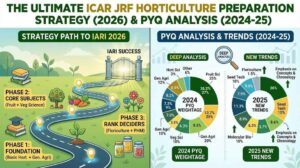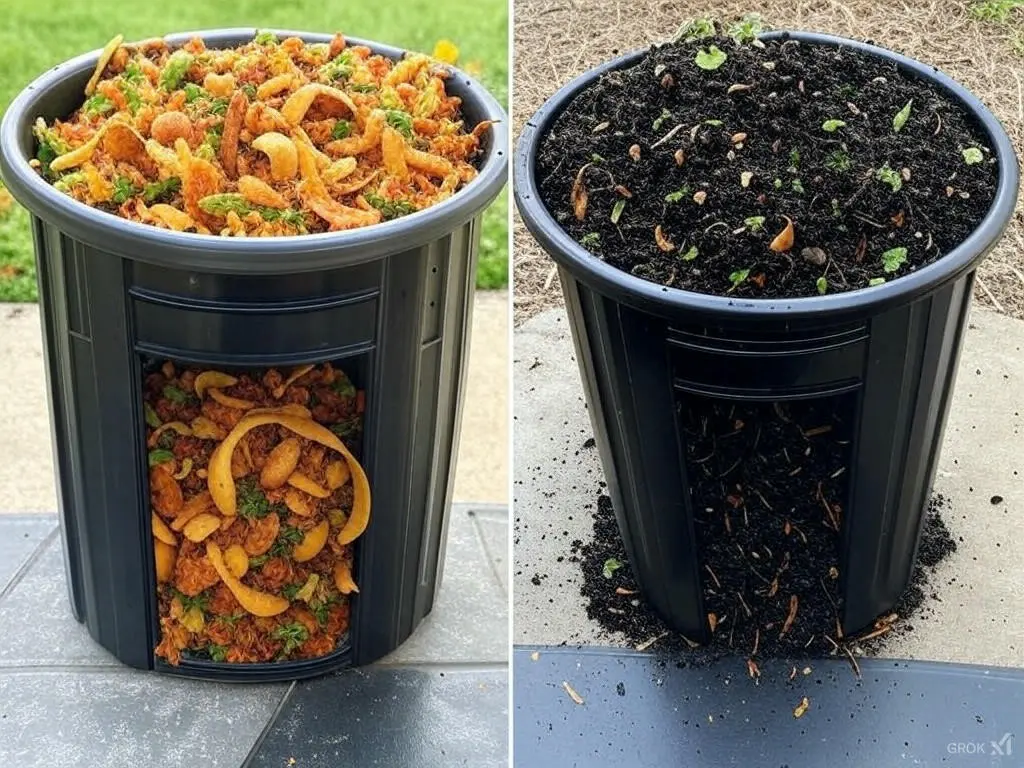
Did you know the average household throws away over 200 pounds of kitchen waste annually? Most of this ends up in landfills, releasing methane—a greenhouse gas 25x more potent than CO₂. But what if you could turn banana peels, coffee grounds, and eggshells into a nutrient-rich superfood for your garden? Does the average household toss 30% of its food into the trash? That’s like throwing away a full grocery bag every week! But what if those banana peels, coffee grounds, and carrot tops could become nutrient-rich compost instead? Imagine transforming waste into “black gold” for your garden while shrinking your carbon footprint. Let’s explore how to make compost from kitchen waste—a simple, eco-friendly habit anyone can master.
What is Composting? Nature’s Recycling System Explained
Composting is a natural process in which organic waste, such as vegetable peels, fruit scraps, and kitchen waste, is broken down by microorganisms (bacteria and fungi). During this process, this waste is converted into compost, which becomes a natural fertilizer for the soil.
The main goal of composting is to recycle our waste and make it a valuable resource. When organic materials decompose, they release rich nutrients and minerals that enhance soil fertility. This process is very useful for sustainable farming and gardening practices as it promotes healthy growth in our garden and reduces the use of chemical fertilizers.
Apart from this, composting is a very good way of waste management, through which we reduce landfill waste and save the environment from pollution.
The Science Simplified:
Decomposition: Microbes (bacteria, fungi) and macrobes (worms, insects) feast on waste, breaking it into simpler compounds.
Carbon-to-Nitrogen Ratio: The ideal “recipe” is 25–30 parts carbon (browns like dry leaves) to 1 part nitrogen (greens like veggie scraps).
Soil Superpowers: Compost improves soil structure, retains moisture, and suppresses plant diseases.
By composting, you’re not just reducing waste—you’re creating a thriving ecosystem in your backyard!
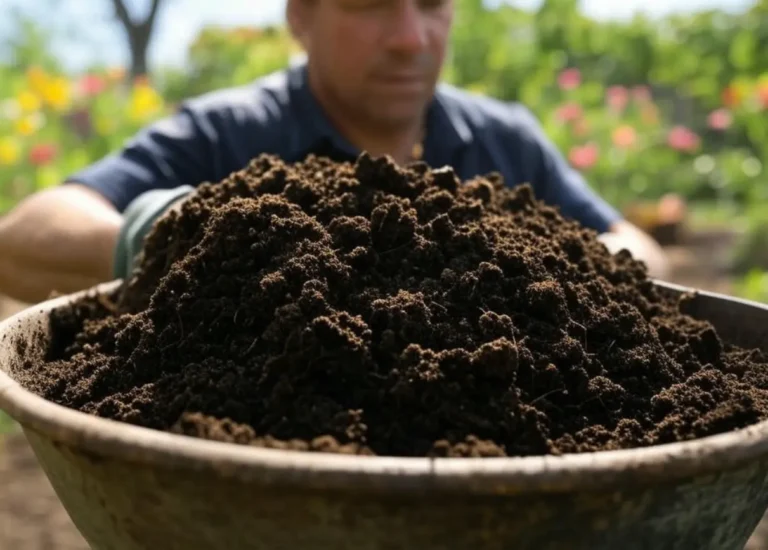
What Can and Cannot Be Composted?
Before you start composting your kitchen wast and other substances, you must know what materials you can and cannot add to your compost pile.
✅Compostable Kitchen Waste (Green Materials)
Vegetable and fruit peels
Coffee grounds and filters
Tea bags (without synthetic components)
Eggshells
Cooked grains (in small quantities)
Leftover salads (without dressing)
Crushed nutshells
Herbs and spices
Used paper napkins (non-glossy)
(✔ Vegetable and fruit peels (banana, orange, apple, etc.) ✔ Coffee grounds and filters ✔ Tea bags (without plastic) ✔ Eggshells ✔ Stale bread and grains ✔ Crushed nutshells ✔ Leftover rice and pasta (in small amounts) ✔ Spoiled fruits and vegetables ✔ Corn cobs and husks)
❌Non-Compostable Kitchen Waste
Dairy products
Meat, fish, and bones
Oily or greasy food scraps
Citrus peels in large quantities (they can slow decomposition)
Plastic, glass, or metal items
Pet waste
Synthetic tea bags or coffee pods
Treated or coloured paper products
(✖ Meat, fish, and dairy products (attract pests and create odour) ✖ Oily and greasy food waste ✖ Processed and cooked food (contains salt and preservatives) ✖ Citrus peels (slow to decompose and can make the soil too acidic) ✖ Plastic, metal, and glass ✖ Diseased plants and weeds with seeds)

Types of Composting Methods: Which One Fits Your Lifestyle?
Not all composting methods are the same. The best composting methods for different types are discussed in this article on how to make compost from kitchen waste Depending on your space, time, and effort, you can choose one of the following:
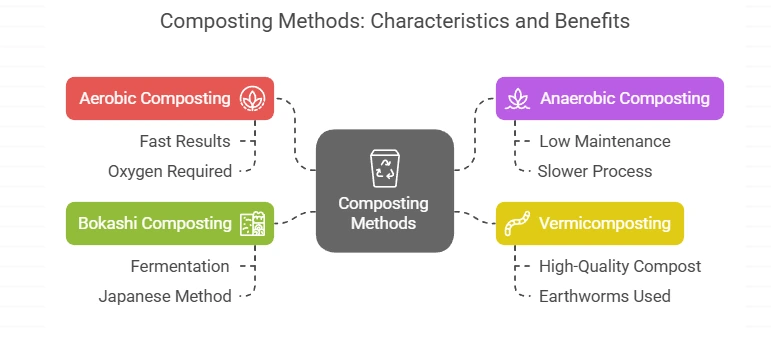
Aerobic composting is a natural process in which organic waste is decomposed in the presence of oxygen. In this, microorganisms like bacteria and fungi break down the waste and generate heat, which completes the composting process faster. This method is environmentally friendly and produces nutrient-rich compost for the garden. Aerobic composting reduces the use of chemical fertilizers, and you can promote sustainable farming by recycling your kitchen and garden waste.
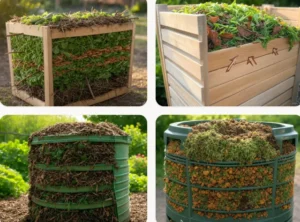
How It Works-
- Oxygen Requirement: Microorganisms, mainly bacteria and fungi, require oxygen to decompose organic matter efficiently.
- Heat Generation: The microbial activity generates heat, which accelerates decomposition and helps kill pathogens and weed seeds.
- Regular Turning: To maintain proper oxygen levels, the compost pile needs to be turned regularly. This also ensures even decomposition and prevents foul odours.
- Moisture and Carbon-Nitrogen Balance: Maintaining the right balance of “greens” (nitrogen-rich materials like food scraps) and “browns” (carbon-rich materials like dry leaves) is crucial for optimal decomposition.
How to Start Aerobic Composting-
- Choose a Composting Spot: Pick an outdoor area with good drainage and access to air.
- Layer the Materials: Start with a layer of coarse materials (twigs, dry leaves) at the bottom for airflow. Alternate between green and brown materials.
- Maintain Moisture: The pile should feel like a damp sponge. Too dry? Add water. Too wet? Add more brown materials.
- Turn the Pile Regularly: Every few days, use a pitchfork or compost aerator to mix and aerate the pile.
Advantages-
✅ Fast Decomposition – Compost can be ready in as little as 2-3 months.
✅ Odor Control – Proper aeration prevents foul-smelling gases like methane.
✅ Kills Pathogens & Weed Seeds – The high temperatures destroy harmful microbes and unwanted seeds.
2. Anaerobic Composting (Low Maintenance, Slower Process)
Before choosing how to make compost from kitchen waste method do you know Anaerobic composting is a method where organic materials decompose without oxygen? This process takes longer than aerobic composting and can produce strong odours due to the formation of methane and hydrogen sulphide
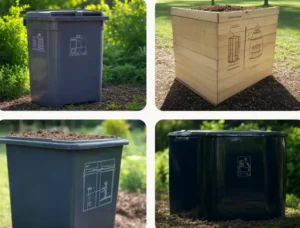
How It Works-
- Oxygen-Free Environment – Organic waste is placed in an airtight container or a pit, preventing oxygen from entering.
- Microbial Breakdown – Anaerobic bacteria break down the materials slowly, producing gases like methane.
- Leachate Formation – A liquid byproduct called leachate is produced, which can be used as a fertilizer when diluted.
How to Start Anaerobic Composting-
- Dig a Pit or Use a Sealed Container – Ensure no oxygen enters the composting system.
- Add Organic Waste – Include food scraps, manure, and plant materials. Avoid too much dry material.
- Seal It Off – Cover the pit with soil or close the container tightly.
- Wait for Decomposition – The breakdown process can take 6 months to 2 years.
Advantages-
✅ Low Maintenance – No turning or aeration is required.
✅ Works in Large Quantities – Ideal for large-scale farms or waste management facilities.
✅ Can Be Done Underground – Composting pits can be dug to manage space efficiently.
Disadvantages-
❌ Slow Process – several months to years to fully decompose.
❌ Strong Odors – Produces foul-smelling gases like ammonia and hydrogen sulphide.
❌ Methane Emissions
3. Vermicomposting (Using Earthworms for High-Quality Compost)
In this guide on how to make compost from kitchen waste, different types of best composting methods are presented, among which the vermicompost method is one of the best methods. Vermicomposting is a composting method that relies on earthworms—especially red wigglers (Eisenia fetida)—to break down organic waste into nutrient-rich worm castings. This method is excellent for producing high-quality compost, especially in small spaces like apartments or indoor setups.
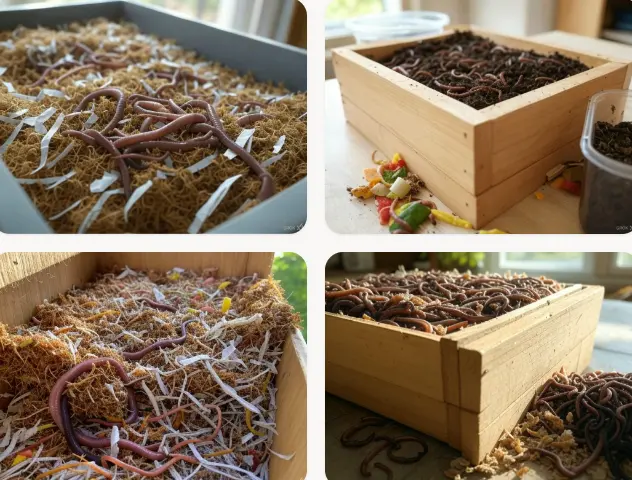
How It Works-
- Worms Consume Waste – Worms eat organic matter and digest it, turning it into nutrient-rich castings.
- Moist & Aerated Environment – The composting bin needs to stay damp and well-aerated for worms to thrive.
- Regular Harvesting – Finished worm castings are collected and used as fertilizer.
- Get a Worm Bin – Use a plastic or wooden bin with drainage holes.
- Prepare Bedding – Use shredded newspaper, coconut coir, or cardboard for the worms’ habitat.
- Add Red Wigglers – These worms are best for composting.
- Feed Them Regularly – Provide vegetable scraps, fruit peels, and coffee grounds in small amounts.
- Harvest Worm Castings – After 2-3 months, collect the nutrient-rich compost for plants.
✅ Produces High-Quality Compost – nutrient-rich and beneficial for soil health.
✅ Odor-Free – When properly maintained
✅ Great for Small Spaces – This can be done indoors with minimal space requirements.
Disadvantages-
❌ Worm Care Required – Worms need the right environment (temperature, moisture, and food).
❌ Limited Waste Capacity – Works best for kitchen scraps but not for large-scale composting.
❌ No Meat or Dairy – These can attract pests and harm the worms.
Before choosing how to make compost from kitchen waste method do you know Bokashi composting is a unique anaerobic composting method that uses beneficial microbes to ferment organic waste, including items typically not suited for traditional composting, like meat and dairy. It’s a great option for those who want to compost all their food waste with minimal effort.
How It Works-
- Microbial Fermentation – Bokashi bran (a mix of wheat bran and beneficial microbes) is sprinkled over food scraps in an airtight bin.
- Anaerobic Breakdown – Over 2-4 weeks, the microbes ferment the waste instead of decomposing it.
- Final Burial or Composting – The fermented waste is then buried in soil or added to a compost pile for final decomposition.
How to Start Bokashi Composting-
- Get a Bokashi Bin – An airtight bin is essential for the process.
- Add Food Scraps & Bokashi Bran – Layer scraps with a handful of Bokashi bran to encourage fermentation.
- Seal & Wait – Keep the bin closed for 2-4 weeks while the microbes work.
- Bury the Waste or Add to Compost – The fermented waste should be buried in the soil or added to a compost pile for final breakdown.
Advantages-
✅ Works for All Food Waste – Unlike other composting methods, Bokashi can handle meat, dairy, and oily foods.
✅ Compact & Odor-Free – The airtight container prevents smells and can be kept indoors.
✅ Fast Process – Fermentation takes only 2-4 weeks.
Disadvantages-
❌ Requires Bokashi Bran – You need to buy or prepare special microbial bran.
❌ Needs a Second Step – The fermented waste must be buried or further composted before use.
❌ Limited Large-Scale Application – Best for households, not for farms or large operations.
How to choose best compost method
Before choosing how to make compost from kitchen waste, identify the best composting method that best suits your environment and needs. Here methods of making compost have been compared. You can choose the best method according to your needs.
| Method | Process Type | Time Required | Best For | Maintenance |
|---|---|---|---|---|
| Aerobic Composting | Oxygen-based decomposition | 2-3 months | Home gardens, fast composting | Regular turning needed |
| Anaerobic Composting | Oxygen-free decomposition | 6 months – 2 years | Large farms, minimal effort | No turning required |
| Vermicomposting | Worm-based breakdown | 2-3 months | Apartment composting, high-quality compost | Worm care needed |
| Bokashi Composting | Microbial fermentation | 2-4 weeks + soil burial | Indoor composting, all food waste (meat too) | Needs Bokashi bran |
| Trench Composting | Direct soil decomposition | 2-6 months | Gardeners wanting easy, hidden composting | No maintenance |
| Hot Composting | High-temperature aerobic | 1-2 months | People wanting fast, high-heat composting | Frequent turning required |
| Industrial Composting | Large-scale controlled process | 2-6 months | Municipal waste management, large-scale composting | Managed by professionals |
Best Composting Method for You?
- For Fast & Effective Composting → Aerobic Composting 🏆
- For Minimal Effort (but Slow) → Anaerobic Composting 🏗️
- For High-Quality, Indoor Composting → Vermicomposting 🪱
- For Composting All Food Waste (Including Meat) → Bokashi Composting 🍞
Step-by-Step Guide: How to Make Compost from Kitchen Waste
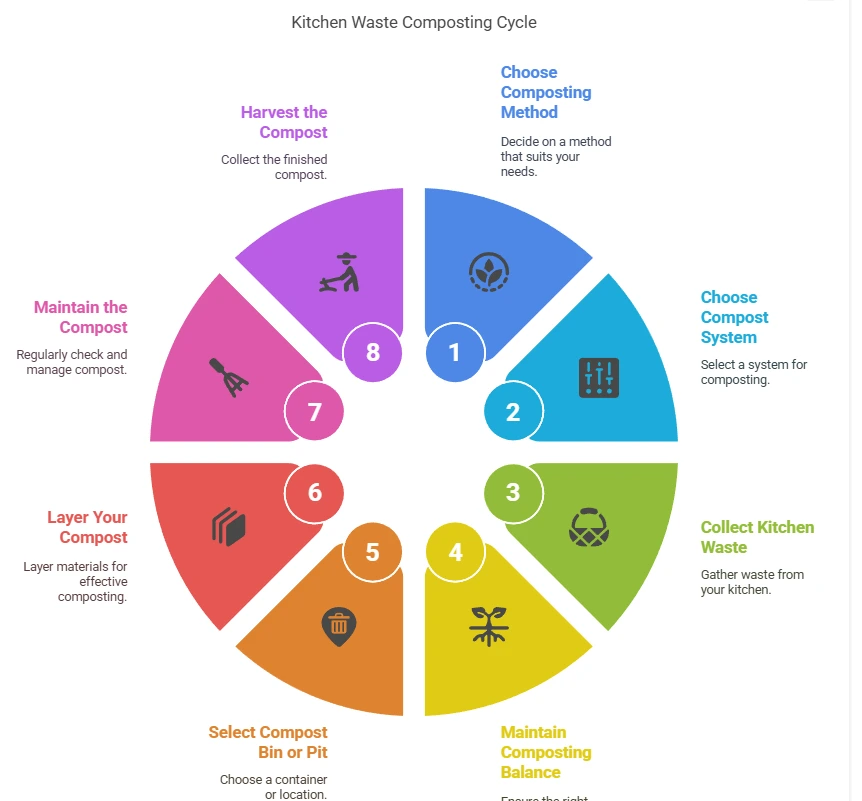
how to make compost from kitchen waste. Here, a mist plays an important role in deciding how good our compost will be and how many rich nutrients it will contain, which are beneficial for our plants, so we have to use the best strategy so that we can prepare the best compost. Here are some steps on how to make compost from kitchen waste
Materials Needed
Compost Bin/Container: Outdoor pile, tumbler, indoor bin (e.g., worm bin for apartments).
Kitchen Scrap Container: Small countertop bin with a lid.
Brown Materials: Dry leaves, shredded paper, cardboard, straw (carbon sources).
Green Materials: Fruit/veggie scraps, coffee grounds, tea bags, eggshells (nitrogen sources).
Tools: Shovel/pitchfork, garden gloves, spray bottle for water.
Optional: Soil/compost starter (to boost microbes).
Step 1: Choose Your Composting Method
In this guide’s 1st steps on how to make compost from kitchen waste, it is important to select the best, easiest, low-cost method according to your suitability. But there are many other methods of making compost, you can choose any one method according to your needs.
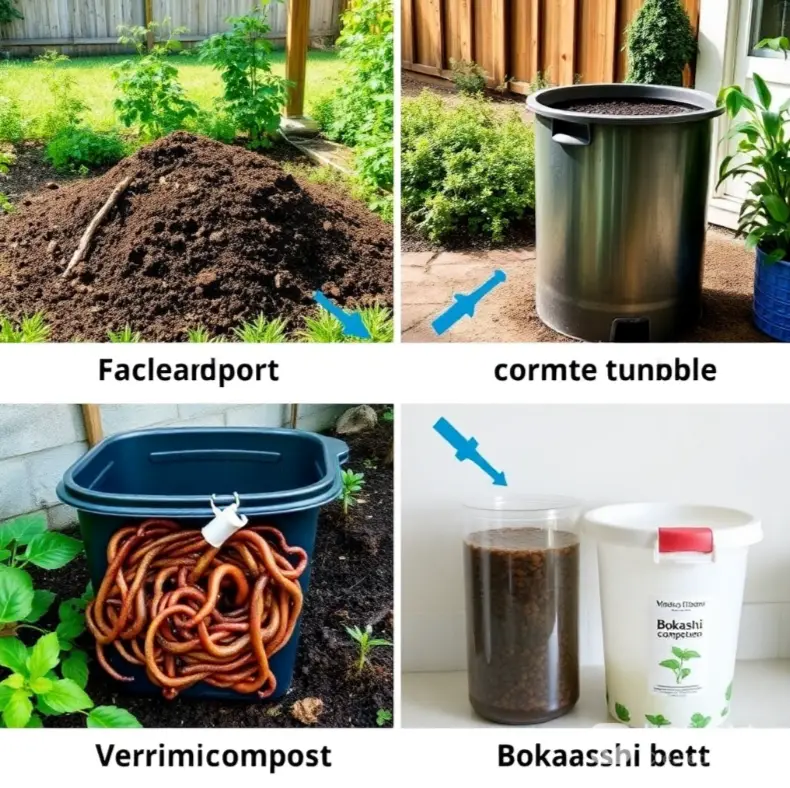
Methods
Aerobic Composting
Anaerobic Composting
Vermicomposting
Bokashi Composting
Trench Composting
Hot Composting
Step 2: Choose Your Compost System
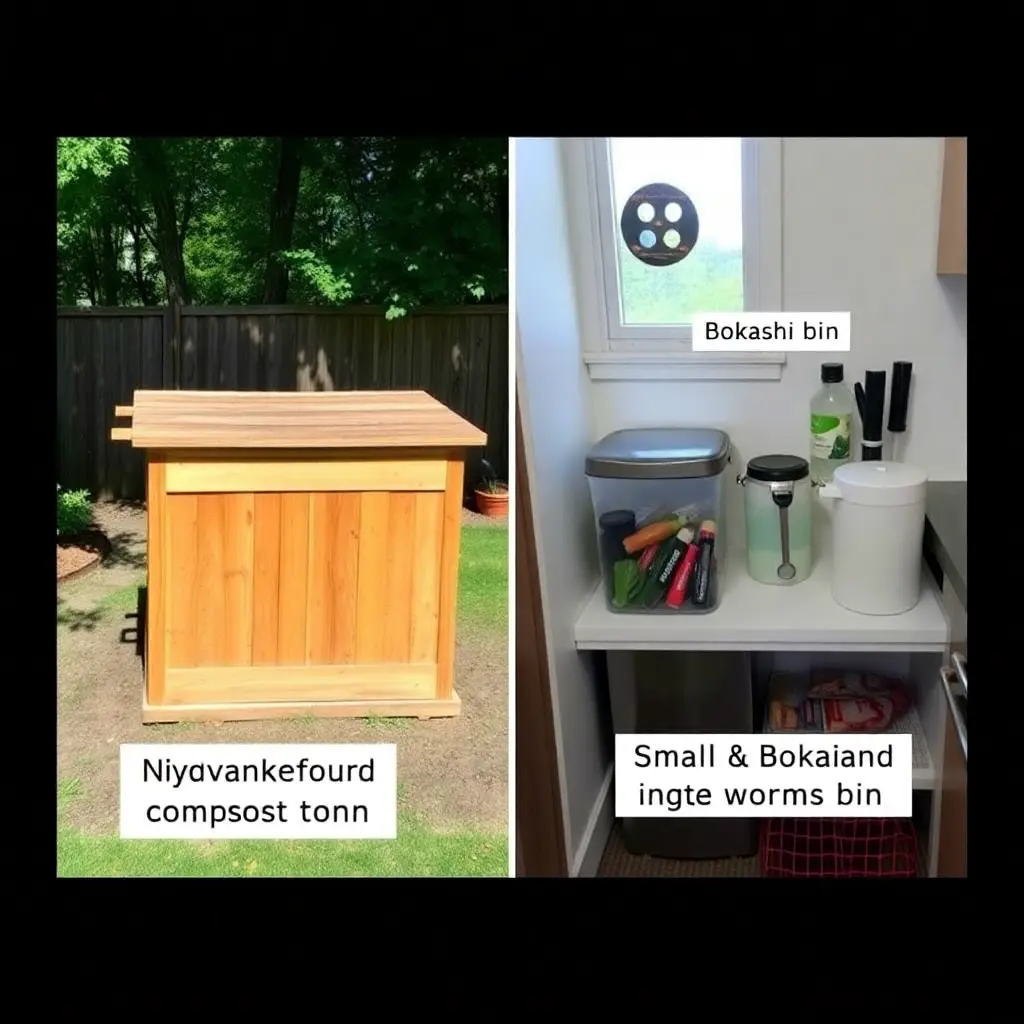
The second step of how to make compost from kitchen waste is to choose your compost system which mostly consists of two methods 1st outdoor and 2nd indoor method
If using a bin or pile, place it in a well-drained, partially shaded area. Ensure proper aeration and drainage to facilitate decomposition. A compost bin should have ventilation holes to allow airflow and avoid excessive moisture buildup.
Outdoor: Use a pile or tumbler if you have a yard.
Indoor: Opt for a sealed bin (e.g., Bokashi) or vermicomposting (worms) for small spaces.
Step 3: Collect Kitchen Waste
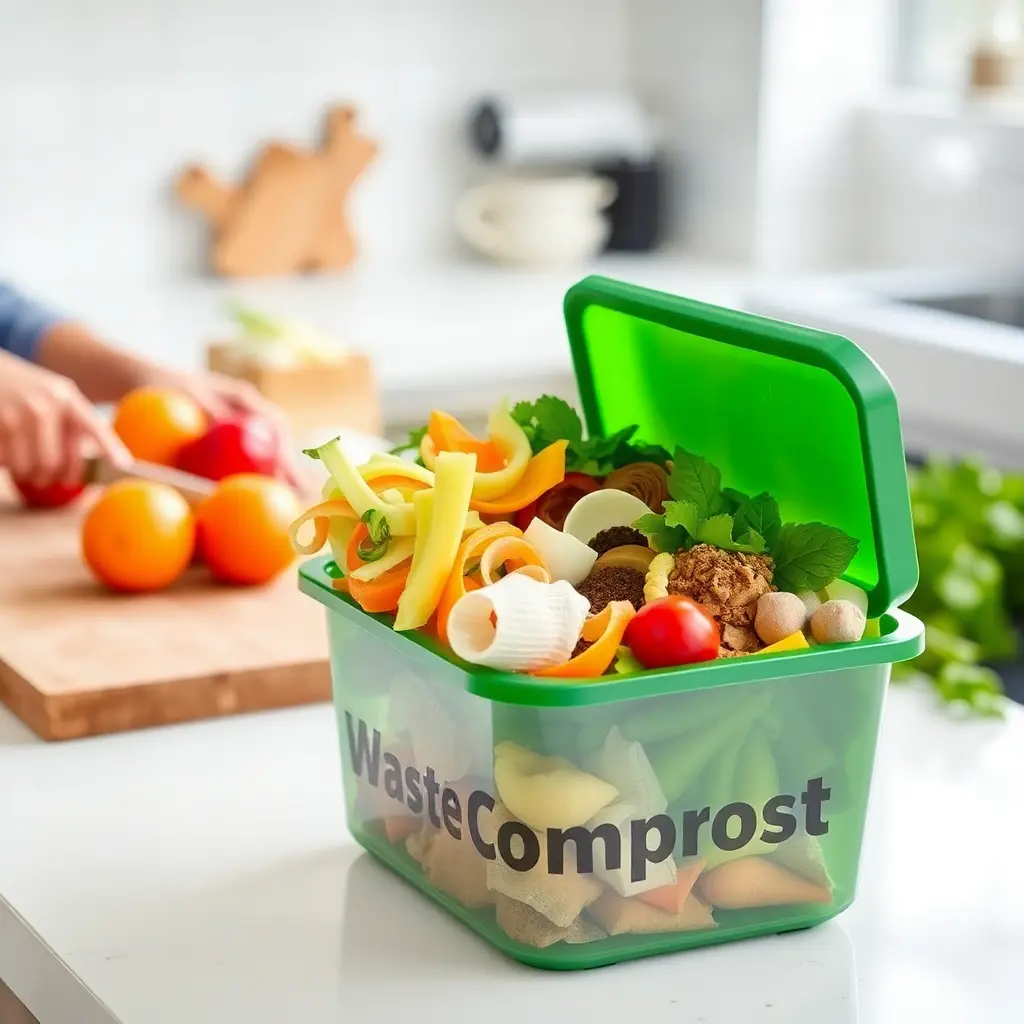
How to make compost from kitchen waste? The third step is to collect how much waste, which is the most important method. In this step, we get to know about the compostable resources of the kitchen.
What to Compost:
Fruit and vegetable peels
Coffee grounds and tea bags
Crushed eggshells
Rice, bread, and grains (in moderation)
Leftover cooked vegetables (without oil or dairy)
Shredded paper or cardboard (for additional carbon content)
What NOT to Compost:
Meat, fish, and dairy
Oily or greasy food scraps
Plastic, glass, or metal
Citrus peels in large amounts (can disrupt microbial balance)
Step 4: : Maintain the Right Composting Balance
In the fourth step of how to make compost from kitchen waste, the composting material is maintained so that the best quality compost can be obtained. A successful compost pile needs the right mix of green and brown materials:
Greens (Nitrogen-Rich): Fruit scraps, vegetable peels, coffee grounds.
Browns (Carbon-Rich): Dry leaves, paper, sawdust.
The ideal ratio is 2 parts brown to 1 part green to maintain a healthy decomposition process. If your compost pile smells bad, it may be too wet—add more brown materials.
Step 5: : Select a Compost Bin or Pit
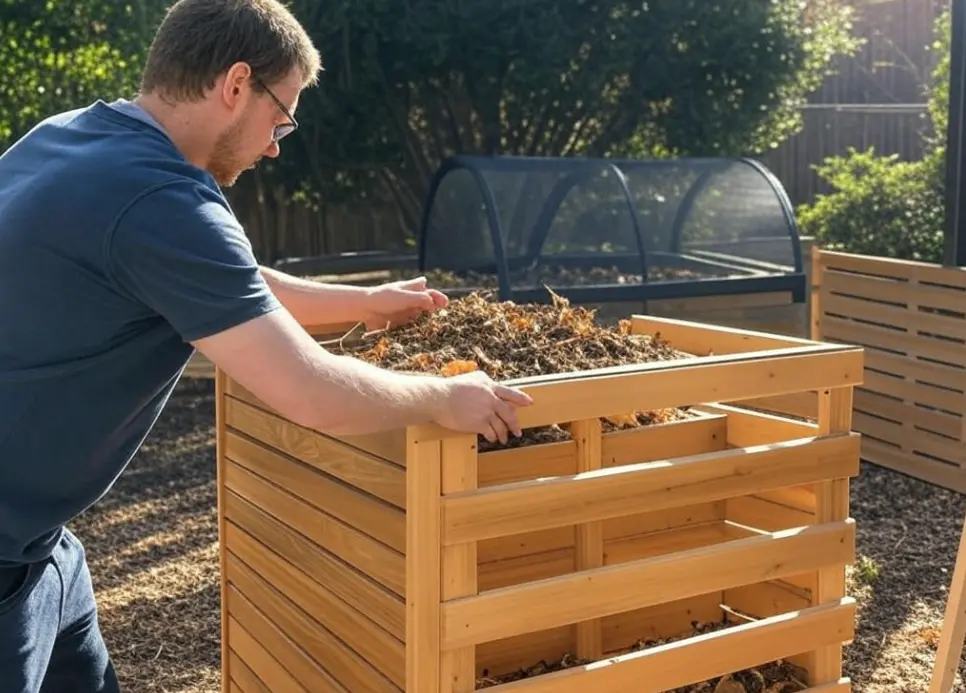
In the fifth step of how to make compost from kitchen waste, a compost bin and pit are selected so that the compost can be protected from diseases and insects. You can choose from:
Open compost piles (suitable for large backyards).
Compost bins (ideal for urban spaces).
DIY compost pits (affordable and effective).
Tumbler bins (designed for quick and efficient composting with easy turning mechanisms).
Step 6: : Layer Your Compost
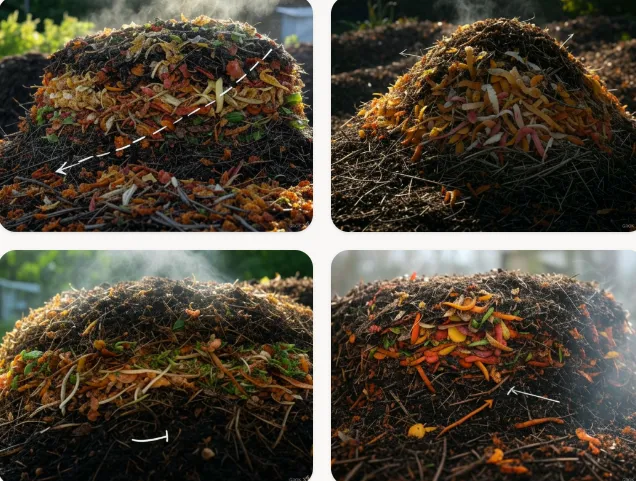
In this step of how to make compost from kitchen waste, different layers of kitchen waste are kept one after the other so that all the kitchen waste can be decomposed.
Base Layer: Start with coarse browns (twigs, straw) for airflow.
Alternate Layers:
Browns: 2–3 parts (e.g., dried leaves, shredded paper).
Greens: 1 part (kitchen scraps).
Soil/Starter: Sprinkle between layers to introduce microbes.
Moisten: Dampen layers (like a wrung-out sponge).
In my experience, chopping scraps into small pieces speeds up decomposition.
Step 7: Maintain the Compost
Turn Weekly: Aerate with a shovel to prevent odors and speed breakdown.
Monitor Moisture: Add water if dry; add browns if too wet.
Check Temperature: A warm center indicates active decomposition.
Step 8: Harvest the Compost
This is the last step of how to make compost from kitchen waste, in which after 3 to 5 months the kitchen gets completely decomposed and forms in dark black colour
When Ready: Dark, crumbly, earthy-smelling (3–6 months for outdoor; 2–4 months for tumbler/worm bin).
Sift: Remove undecomposed bits (return to bin).
Use: Mix into garden soil, use as mulch, or brew compost tea.
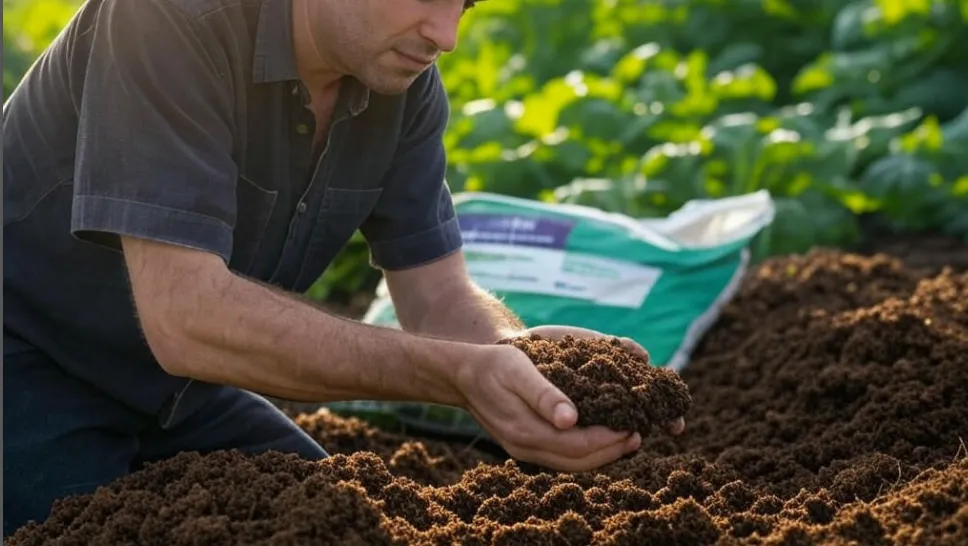
Common Composting Problems & Solutions
1. Bad Odor?
✔ Add more brown waste like dry leaves or shredded paper. ✔ Turn the pile regularly for aeration.
2. Compost Too Wet?
✔ Add dry materials to absorb excess moisture. ✔ Ensure proper drainage in the compost bin.
3. Pests in the Compost?
✔ Avoid meat, dairy, and oily food waste. ✔ Keep the compost covered properly.
4. Slow Decomposition?
✔ Chop large scraps into smaller pieces before adding. ✔ Maintain a good green-to-brown waste balance. ✔ Turn the pile frequently.
Real-Life Example: Success Story of Home Composting( how to make compost from kitchen waste)
Meet Anjali Sharma – A Zero-Waste Advocate from Pune, India
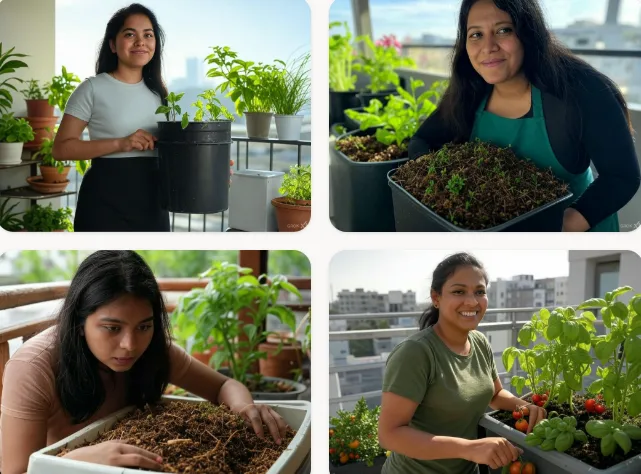
Anjali Sharma, a 35-year-old homemaker from Pune, started her home composting journey in 2021 to reduce her household waste. Initially, she was overwhelmed by the idea of composting, fearing bad odours and pests. However, after learning about aerobic composting, she decided to give it a try.
How She Started:
- Choosing a Method: She opted for a simple aerobic compost bin on her balcony.
- Setting Up a Bin: She used a plastic bucket with holes for airflow and added layers of dry leaves and kitchen waste.
- Managing Waste: She ensured a balance of greens (fruit & vegetable peels) and browns (dry leaves, paper, and coconut husk) to avoid foul smells.
- Turning the Compost: Every 4-5 days, she mixed the compost with a stick for aeration.
Challenges Faced & Solutions:
🚫 Bad Odor? – She added more dry leaves and ensured proper aeration.
🐜 Pests? – She avoided adding cooked food and covered the bin properly.
⏳ Slow Decomposition? – She chopped food scraps into small pieces to speed up the process.
Results After 3 Months:
✅ She successfully turned kitchen waste into rich, black compost.
✅ She used the compost for her home garden, growing organic vegetables and flowers.
✅ She reduced her kitchen waste by 70%, helping her household become more eco-friendly.
Impact & Inspiration:
Anjali now educates her neighbours on composting and has helped over 50 households start their composting bins. Her story proves that anyone can compost at home with minimal effort while reducing waste and creating a greener planet. 🌿♻️
Benefits of Homemade Compost: More Than Just Dirt
When you think of compost, you might picture a pile of decaying leaves or a bin full of food scraps. But the end result—dark, crumbly, earthy-smelling compost—is nothing short of gardening gold. Beyond nourishing plants, homemade compost delivers a powerhouse of benefits for your wallet, your garden, and the planet. Let’s break down why composting is one of the most rewarding habits you can adopt.
A. Supercharged Soil Health: The Foundation of Thriving Plants
Compost is nature’s ultimate soil conditioner. Unlike synthetic fertilizers that offer a quick nutrient fix, compost works slowly and holistically to create a thriving ecosystem underground. Here’s how:
Nutrient-Rich Buffet for Plants
Compost is packed with essential macronutrients (nitrogen, phosphorus, potassium) and micronutrients (calcium, magnesium, iron) that plants need to grow strong. For example:Nitrogen fuels leafy growth.
Phosphorus supports root development and flowering.
Potassium boosts disease resistance.
B. Improved Soil Structure
Soil texture matters! Compost acts like a sponge:
Sandy soil? Compost binds loose particles, improving water retention.
Clay soil? Compost breaks up dense clumps, enhancing drainage and root penetration.
Loamy soil? Compost maintains its ideal balance of air and moisture.
A University of California study found that adding compost increases soil’s water-holding capacity by up to 60%, reducing the need for frequent watering.
C. Microbial Magic
A teaspoon of healthy compost contains billions of beneficial microbes—bacteria, fungi, and protozoa—that:
Break down organic matter into plant-available nutrients.
Suppress soil-borne diseases (e.g., root rot, blight) by outcompeting harmful pathogens.
Think of compost as a probiotic for your soil!

D. Economic Wins: Save Money While Saving the Planet
Composting isn’t just eco-friendly—it’s budget-friendly. Here’s how it impacts your wallet:
Slash Fertilizer Costs
The average gardener spends 50–50–100 annually on synthetic fertilizers. Compost replaces these products entirely. For example:Tomato plants grown in compost-rich soil yield 20–30% more fruit (Rodale Institute).
Flower beds amended with compost bloom longer and require no chemical boosters.
Reduce Water Bills
Compost’s moisture-retaining properties mean you’ll water less often. In drought-prone areas, this can cut outdoor water use by 30–50%.Lower Trash Expenses
Many cities charge per bag for waste removal. By composting kitchen scraps, a family of four can reduce trash volume by 40%, saving 5–5–15 monthly.Avoid Costly Soil Amendments
Store-bought potting mixes and topsoil can cost 10–10–20 per bag. Homemade compost is free—and often higher quality.
E. Environmental Impact: Small Effort, Big Change
Methane Reduction
When organic waste rots in landfills, it produces methane—a greenhouse gas 25x more potent than CO₂. Composting diverts this waste, cutting methane emissions.1 ton of composted waste = 1.5 tons of CO₂-equivalent emissions avoided (EPA).
Less Chemical Runoff
Synthetic fertilizers and pesticides pollute waterways, causing algal blooms and dead zones. Compost eliminates the need for these chemicals, protecting rivers and oceans.Carbon Sequestration
Healthy soils enriched with compost act as a carbon sink. According to the USDA, 1 acre of compost-treated soil can store 5–10 tons of CO₂ annually—equivalent to taking 2–4 cars off the road.
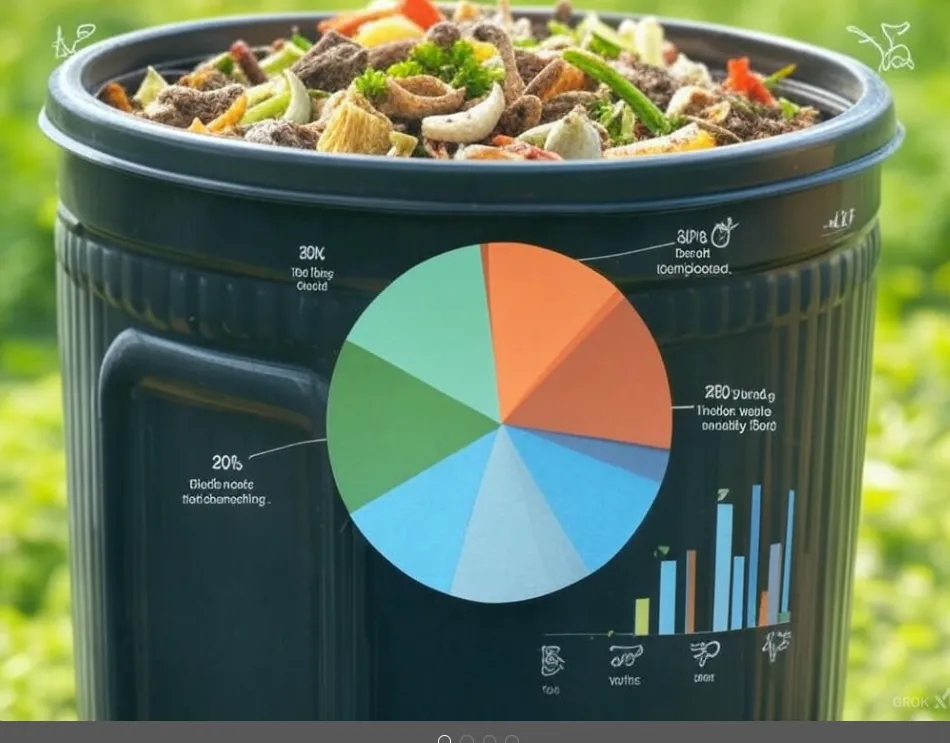
F. Healthier Food and Gardens
Compost isn’t just for plants—it benefits you too:
Nutrient-Dense Produce
Studies show that vegetables grown in compost-rich soil have higher levels of vitamins, antioxidants, and minerals. For example:Spinach contains 30% more iron.
Carrots have 20% more beta-carotene.
Chemical-Free Gardening
Compost reduces reliance on synthetic pesticides, making your homegrown food safer to eat.
Homemade compost isn’t just “dirt”—it’s a multifaceted solution to modern environmental and economic challenges. By turning kitchen waste into a resource, you’re not only nurturing your garden but also contributing to a healthier, more sustainable world.
Fun Fact: If every U.S. household composted for one year, it would reduce emissions equal to taking 7.8 million cars off the road (Project Drawdown).
So, the next time you toss coffee grounds into your compost bin, remember: You’re not just feeding your plants. You’re fueling a revolution. 🌎✨
Frequently Asked Questions (FAQs)
♻️ Follow these simple steps to turn kitchen waste into compost:
1. Choose a Composting Method
- Aerobic Composting (Fast, needs turning)
- Vermicomposting (Using worms, great for small spaces)
- Bokashi Composting (Fermentation, works for all food waste)
2. Select a Compost Bin
- Use a bucket, bin, or pile (with holes for airflow).
3. Collect Kitchen Waste
✅ Use: Vegetable peels, fruit scraps, eggshells, tea/coffee grounds.
❌ Avoid: Meat, dairy, oily food (unless using Bokashi).
4. Layer Properly
- Start with dry leaves/paper (browns).
- Add food scraps (greens).
- Repeat layers & sprinkle soil for microbes.
5. Maintain Moisture & Airflow
- Keep it moist like a damp sponge (not too wet/dry).
- Turn the pile every few days (for aerobic composting).
6. Let It Decompose
- In 2-3 months, you’ll get dark, crumbly compost! 🌿
✅ Use compost in your plants & garden for healthy soil! 🌱♻️
1. Fruit and Vegetable Scraps
- Peels (apple, banana, potato, carrot, etc.)
- Core (apple, pineapple)
- Citrus rinds
- Stems, leaves, and tops (from tomatoes, radishes, or herbs)
- Wilted greens (lettuce, spinach, etc.)
2. Coffee Grounds and Filters
- Used coffee grounds (great for compost)
- Paper coffee filters
3. Eggshells
- Crushed eggshells add calcium to your compost.
4. Tea Bags
- Paper or natural fiber tea bags can be composted.
- Avoid bags with synthetic materials.
5. Nut Shells
- Peanut shells, almond shells, walnut shells, etc.
6. Food Scraps
- Leftovers (vegetable-based, without oils or meat)
- Pasta (without sauce)
- Bread (in moderation, avoid too much processed bread)
7. Herbs and Spices
- Used or wilted herbs
- Spices in small quantities
Kitchen Waste You Should Avoid Composting
❌ Meat and Fish Scraps (attracts pests)
❌ Dairy Products (can cause odors and attract pests)
❌ Oily or Greasy Foods (can make the compost too wet and smelly)
❌ Citrus Peels (in excess, they can be too acidic for compost)
❌ Processed or Packaged Foods (contain preservatives or chemicals)
Composting is the process of turning organic waste (food scraps, leaves, etc.) into nutrient-rich soil. Microorganisms, fungi, and insects break down the materials into simpler forms, producing compost. The process can be aerobic (requires oxygen, faster) or anaerobic (without oxygen, slower).
Yes, making your own compost is a great idea for several reasons:
- Eco-Friendly: Reduces landfill waste and minimizes your carbon footprint.
- Improves Soil: Provides nutrient-rich compost that boosts soil health and supports plant growth.
- Cost-Effective: Saves money on store-bought fertilizers.
- Easy to Do: Requires minimal effort and space, even for beginners.
- Reduces Waste: Converts kitchen scraps and yard waste into valuable compost
Absolutely! Vermicomposting and bokashi composting are perfect for small spaces.
Your pile might need more greens (nitrogen) or better aeration. Turn it and add fresh scraps.
Yes, but in moderation. They’re acidic and can slow decomposition if added in large amounts.
It depends on the method: aerobic (2–6 months), vermicomposting (2–3 months), bokashi (4–6 weeks).
Conclusion-
Now that you know how to make compost from kitchen waste, it’s time to take action! Composting is an easy and impactful way to reduce waste, enhance soil fertility, and contribute to a greener planet.
Ready to start composting? Share your thoughts or experiences in the comments below! If you found this guide helpful, share it with friends and family to spread awareness of sustainable living.
Final Tip: Keep a small compost bin in your kitchen to collect daily scraps. It makes the process more convenient and encourages consistent composting habits! Also, share your composting experience with your community—it might inspire others to start their eco-friendly journey.
References
Smith, J., & Gupta, R. (2024). “Composting: Turning Waste into Fertile Soil.” Green Solutions Journal. Retrieved from greensolutions.com.
Bansal, K., & Singh, P. (2024). “Kitchen Waste Composting Techniques: A Step Toward Sustainable Living.” Agricultural Sustainability Review. Retrieved from agrisustain.com.
Sharma, A. (2024). “How Kitchen Waste Can Help Us Create Organic Compost.” Sustainable Environment Journal. Available at sustainenv.com.
Kumar, P., & Mehta, S. (2024). “A Guide to Effective Composting from Kitchen Waste.” Green Earth Practices. Retrieved from greeneearthpractices.com.
Jain, M. & Verma, R. (2025). “Kitchen Waste Composting for Urban Gardening.” Nature-Friendly Living Blog. Available at naturefriendlyliving.com.
National Composting Association (2025). “Composting Methods for Beginners.” Environmental Education Forum. Retrieved from composting.org.
Soni, V., & Patel, R. (2025). “How Composting Kitchen Waste Benefits Your Garden.” Eco-Friendly Gardening Guide. Available at ecofriendlygardening.com.
Fundamentals of Genetics by B.D. Singh Book PDF: A Comprehensive Review & Why It’s a Must-Have for Agri Students
Let’s be honest for a second—when most of us join...
Read MoreThe Ultimate ICAR JRF Horticulture Preparation Strategy (2026) & PYQ Analysis (2024-25)
Table of Contents Are you overwhelmed by the vast syllabus...
Read MoreBest Books for ICAR JRF Horticulture 2026: The Topper’s Booklist (Updated)
Table of Contents Are you still dreaming of IARI relying...
Read More

